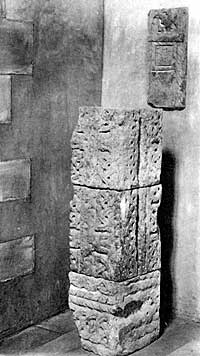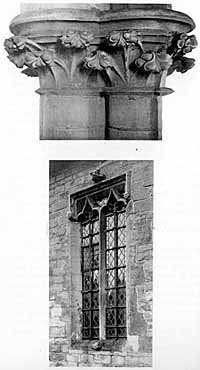
Rolleston Church. Fragments of Celtic Cross.
In the 15th century, also, new square-headed two-light windows were inserted in the south aisle. The gargoyle now to be seen there is of the same period, but does not belong to its present position. The lower part of the chancel screen is of the 15th century, the upper part is a restoration by Mr. Hodgson Fowler. There is no trace of a rood-loft.
At some time in the 16th century the clerestory was added, of somewhat rude and inartistic design. The height of the nave roof before this addition remains marked on the wall over the tower arch.
The mediaeval font probably shared the fate of most of those round Newark during its long siege in the civil wars of the 17th century, the present font being apparently of the Charles II. period.
It does not appear that the church had any porch in ancient times. A modern one, of no architectural character, protected the south door before the restoration of the church in 1895.
The private chapel of the Nevills, who formerly had a manor house here, stood alongside the easternmost bay of the north aisle. I do not know when it was removed. It has left no trace, beyond the mark on the inside wall of the aisle, where the opening into the chapel ended.
I do not feel sure as to whether there were altars in the ends of the narrow side-aisles. The piscina in the south aisle has certainly been moved, and I do not know if it now occupies its original position. Within its arch stands the bowl of a Norman shaft-piscina. It seems clear that two altars stood against the chancel screen, and that a parclose ran right across the church, cutting off the eastern bay of the nave.
Many fragments of old work may be seen built into the inside walls, including a paving tile at the west end of the south aisle. There are also many ancient stone coffin-lids, with incised or raised crosses. One of the latter, in the east end of the south aisle, has been set wrong way round, with the cross towards the east. The most ancient fragments are in the porch, in the wall on the east side of the doorway. They have to me a Saxon look. A small brass plate, commemorating Thomas Buttfeled, vicar in 1535, is fastened to the back of the chancel screen. I do not know whether this has been its original position.

Rolleston Church. (1) Capital: South Arcade. (2) Window in North Wall of Chancel.
The restoration of the church in the 19th century passed through several stages. The chancel was the first part to be taken in hand. It was restored by the Ecclesiastical Corn. missioners—into whose hands had passed the tithes, formerly appropriated to one of the Southwell prebends— from designs, I believe, by Mr. Christian. The roof, which had been flattened, was raised to what was probably its original pitch. Next in date came the repair of the tower, as already described. Then, in 1895, there was a restoration of the nave and aisles, under Mr. Naylor, when many things were done which one cannot but regret. The south aisle was taken down and rebuilt. The doorway was moved one bay westward, and a new porch provided. So far, so good. But a stone altar, which had been placed in the chancel by Mr. Hodgson Fowler (whose father was formerly vicar of Rolleston) was removed, and its slab ignominiously used as the lintel of the easternmost window of the new south aisle wall (where one of the crosses cut upon it can still be faintly discerned), while the cross, which the same architect had placed on the restored screen, was wantonly destroyed. Worst of all, a quantity of fine old benching, which had survived in the nave, was broken up. Some few pieces may be seen, up in the ringing chamber of the tower. The attempt to level the somewhat uneven floor of the nave resulted in the chancel being brought level with the nave. These had been anciently one step up, from nave to chancel. The chancel arch, as already mentioned, was raised by lengthening the jambs—a proceeding for which one does not see the necessity. Finally, under the happier auspices of Mr. Hodgson Fowler, the restoration was completed by the re-roofing of the nave and north aisle, and a new cross was placed on the chancel screen.
Mr. Blagg informs me that the Rolleston registers are peculiarly interesting. They date from 1584.
The three pieces of the shaft of a Saxon stone cross now standing in the north-west corner of the nave have at some time been ruthlessly cut about and made to serve as a door-jamb. The original ornamentation remains at one corner and on two of the faces. Another piece was, in 1895, built into the wall just above. On it may be seen what appears to be one of the symbols of the four evangelists, and the inscription RAdvLFVS ME FE (cit). The style of lettering seems to indicate a date not very long before the Norman conquest. It is not certain that this piece belongs to the same cross as the other three.
The four bells bear the following inscriptions :—I., “God save His church. N. W. and W. W. Wardens, 1697.” II., “1628. I sweetly tolling men do call: to taste on meats that feede the soule,”—an Oldfield motto. III., “Illi fecerunt me in honore Trinitatis.” IV., “1778. All ye who hear my mourneful sound: repent before your layd in ground.” The crown of the bell has impressions of the following coins:— shilling of George III., obverse; half.crown of George II., obverse; crown of George II., reverse; guinea of George II., reverse.
The manor-house of the Nevills was still standing in 1820. Its site is well marked, with the moat, the fish-ponds, &c. Four large carved stones, of the 15th century, which formed part of its ornamentation, still survive: two in the garden of the farm-house opposite the church, and two built into a barn adjoining the site of the manor-house. On them appears the Nevill saltire, impaling a lion rampant. In front of where the house stood is also the stump of a stone cross. The stump of another cross is to be seen in the village, by the road-side. When pulling down a cottage lately, some wrought stones came to light, which seem to have formed part of a parapet. They may have come from the demolished Nevill chapel at the church, or from the manor-house. They have now been placed within the church.
Several members visited the moated manor site and fish stews in the village, and also found the stones carved with the Neville arms which now serve to carry the hinges of a barn door. Most of the visitors returned to Nottingham by afternoon train from Rolleston, whilst Some returned to Newark on the conveyances.
